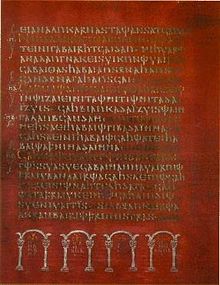Uppsala University Library in Sweden consists of 19 different branch libraries, with the largest being that housed in the old main library building, Carolina Rediviva. The library holds around 5.2 million books and periodicals, 61,959 manuscripts, 7,133 musical prints and 345,734 graphic prints and maps. Users of the library have access to more than 14,000 electronic journals.
History

The exact site of the library during its earliest years is not known, but the university from its foundation in 1477, was located on what became known as "Student Island" in the Fyris River, where the academy mill - now the provincial museum - was later built. In 1566, King Eric XIV donated the old chapter house, south of the Uppsala Cathedral, to be used for lectures. After the construction of the Gustavianum in the 1620s, this building was referred to as the Collegium vetus or Gamla akademien ("the old academy"), until it was renamed in 1704 through a decision of the consistory (university board) and called the Academia Carolina, in honour of kings Charles IX, Charles XI and Charles XII. The library was located in the Academia Carolina from the late 16th century until 1691, when it was moved to one floor of the Gustavianum. The Academia Carolina was damaged in the city fire of 1702, was later restored but continued to decay and finally demolished in the 1770s. An 18th century plan to return the library to the building was never realized and the new library building intended for the spot after demolition was never built. When a new library building was eventually constructed, it received the name Carolina Rediviva, "the revived Carolina", in honour of the old building, but was located to an entirely different place.
The library remained in Gustavianum, which luckily escaped the flames in 1702, until Carolina Rediviva was completed in 1841. Carolina Rediviva has since retained the status of central library of the university until a reorganization in the 1990s did away with the concept of a centralized library organization and divided the library into a number of branch libraries of equal status, with Carolina being home of one of the branch libraries dedicated to humanities and social sciences. Nevertheless, the central functions of the library system largely remain in the building, as do the "cultural heritage units" (the Department for manuscripts and music and the Department for maps and prints).
In parallel with the development of the central library, the "seminars" (later called "departments") of the university had their own libraries. Currently, the collections of the library system is divided over the branch libraries, while at the same time a process of centralizing minor libraries has taken place. In 2004 most of the individual libraries for departments within the Faculties of Arts, Languages and Theology have been collected in the new Karin Boye Library in the new English Park Centre for the Humanities, next to the old cemetery.
Some significant manuscripts and collections

The university library of Uppsala was mainly created through the large donations in the early 17th century of confiscated libraries from monasteries, especially that in Vadstena, and the important collection of Baron Hogenskild Bielke who had been executed in 1605 and whose library was confiscated by the crown and donated by Gustav Adolph in 1621.(http://www.ub.uu.se/arv/special/ebielke.cfm)
The many wars in which Sweden took a part in the 17th century brought many important manuscripts and collections to Sweden as spoils of war, some of which eventually ended up in Uppsala. The most famous example is the Codex Argenteus, most of what remains of Bishop Ulfilas's translation of the New Testament into Gothic, which was taken from Prague. Another example is the Copernicana, the main part of the library of astronomer Nicolaus Copernicus, taken by the Swedish Army in Krakow.
Later donations and purchases include many archives and collections of various Swedish families and individuals, such as the personal papers of King Gustav III, which were left to the library, to be opened only 50 years after the King's death.
More recently acquired collections include the Bibliotheca Walleriana and the Waller manuscript collection, collected by Dr Erik Waller, and partly donated, partly purchased by the library. One of the largest libraries of books concerned with the history of science and medicine and a manuscript collection mostly of letters from notable scientists. The manuscript collection is in the process of being scanned and published on the web: http://waller.ub.uu.se/
The Bodoni collection is the largest collection of prints of Giambattista Bodoni (1740-1813) outside his native Parma. Donated by the industrialist Erik Kempe 1959 and later extended with funds donated at the same time.
The music collections includes the Düben Collection (http://www.musik.uu.se/duben/DubenCollectionInfo.php) which was accumulated from 1640 until 1718 by the Düben family, a German family of musicians which included a number of members serving as Hofkapellmeister of the royal court orchestra. It contains a large selection of 17th century music, notably important works by Buxtehude not elsewhere preserved.

0 comments:
Post a Comment